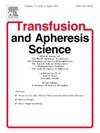转化ABO IgG滴定:在1600例ABO不相容的实体器官移植患者样本中,使用二硫苏糖醇(DTT)灭活IgM的自动SPRCA与CAT的实际比较
IF 1.2
4区 医学
Q4 HEMATOLOGY
引用次数: 0
摘要
抗abo IgG同血凝素(IHA)测定在abo不相容实体器官移植(ABOi-SOT)中起着至关重要的指导作用。柱凝集技术(CAT)虽然应用广泛,但需要DTT预处理以消除IgM干扰。这带来了重大挑战,包括主观性、不一致的IgM失活、频繁的样品凝胶化和延长的周转时间(TAT),所有这些都会影响准确性和标准化。这些限制促使全球对不含dtt的igg特异性方法产生了兴趣,这些方法可以提高分析精度和工作流程效率。研究设计和方法本前瞻性单中心研究(2019年8月- 2024年10月)评估了来自300名ABOi-SOT候选人的1622个样本;对所有人进行基线试验;139例接受移植。在脱敏期和移植后监测期间,通过DTT处理CAT [CAT(DTT)]和SPRCA评估IgG滴度。比较CAT(DTT)和全自动固相红细胞粘附试验(SPRCA)的IHA IgG滴度。和谐,使用Pearson’s相关性评估可重复性,并比较Cohen’s kappa和TATs。结果sprca与IgG滴度的CAT (DTT)相关性较强(r = 0.949;κ = 0.71), 91.4 %的值在±1稀释范围内。SPRCA的平均IgG TAT(65.26 ± 14.41 min)明显低于CAT (DTT)(111.43 ± 19.5 min;p & lt; 0.0001)。SPRCA证明了技术人员之间的差异最小,并且消除了手动dtt前治疗步骤,转化为更快,更一致的结果,从而能够及时做出治疗决策。结论sprca是一个强大的、自动化的、igg特异性的平台,克服了CAT的主要局限性。它在移植工作流程中的实施可以加强标准化,减少延误,并支持更好的结果,在高通量ABOi移植环境中尤其重要。本文章由计算机程序翻译,如有差异,请以英文原文为准。
Transforming ABO IgG titration: Real-world comparison of automated SPRCA vs. CAT with dithiothreitol (DTT) inactivation of IgM in 1600 ABO-incompatible solid organ transplant patient samples
Anti-ABO IgG isohemagglutinin(IHA) titration plays a vital role in guiding ABO-incompatible solid organ transplantation(ABOi-SOT). Column agglutination technology (CAT), though widely used, requires DTT pre-treatment to eliminate IgM interference. This poses significant challenges, including subjectivity, inconsistent IgM inactivation, frequent sample gelling, and prolonged turnaround times(TAT), all of which compromise accuracy and standardization. These limitations have prompted global interest in DTT-free, IgG-specific methods that enhance analytical precision and workflow efficiency.
Study Design and Methods
This prospective single-centre study (August 2019–October 2024) evaluated 1622 samples from 300 ABOi-SOT candidates; baseline titres done for all; 139 underwent transplantation. IgG titers were assessed via DTT-treated CAT [CAT(DTT)] and SPRCA during desensitization phase and post-transplant monitoring. IHA IgG titers were compared between CAT(DTT) and fully automated solid-phase red cell adherence assay (SPRCA). Concordance & reproducibility was assessed using Pearson’s correlation and Cohen’s kappa and TATs compared.
Results
SPRCA showed strong correlation with CAT (DTT) for IgG titers (r = 0.949; κ = 0.71), with 91.4 % of values within ±1 dilution. Mean IgG TAT was significantly lower for SPRCA (65.26 ± 14.41 min) compared to CAT (DTT) (111.43 ± 19.5 min; p < 0.0001). SPRCA demonstrated minimal inter-technologist variability and elimination of manual pre-DTT treatment steps translating to faster, more consistent results, enabling timely therapeutic decisions.
Conclusion
SPRCA is a robust, automated, and IgG-specific platform that overcomes key limitations of CAT. Its implementation in transplant workflows can enhance standardization, reduce delays, and support better outcomes, particularly critical in high-throughput ABOi transplant settings.
求助全文
通过发布文献求助,成功后即可免费获取论文全文。
去求助
来源期刊
CiteScore
3.60
自引率
5.30%
发文量
181
审稿时长
42 days
期刊介绍:
Transfusion and Apheresis Science brings comprehensive and up-to-date information to physicians and health care professionals involved in the rapidly changing fields of transfusion medicine, hemostasis and apheresis. The journal presents original articles relating to scientific and clinical studies in the areas of immunohematology, transfusion practice, bleeding and thrombotic disorders and both therapeutic and donor apheresis including hematopoietic stem cells. Topics covered include the collection and processing of blood, compatibility testing and guidelines for the use of blood products, as well as screening for and transmission of blood-borne diseases. All areas of apheresis - therapeutic and collection - are also addressed. We would like to specifically encourage allied health professionals in this area to submit manuscripts that relate to improved patient and donor care, technical aspects and educational issues.
Transfusion and Apheresis Science features a "Theme" section which includes, in each issue, a group of papers designed to review a specific topic of current importance in transfusion and hemostasis for the discussion of topical issues specific to apheresis and focuses on the operators'' viewpoint. Another section is "What''s Happening" which provides informal reporting of activities in the field. In addition, brief case reports and Letters to the Editor, as well as reviews of meetings and events of general interest, and a listing of recent patents make the journal a complete source of information for practitioners of transfusion, hemostasis and apheresis science. Immediate dissemination of important information is ensured by the commitment of Transfusion and Apheresis Science to rapid publication of both symposia and submitted papers.

 求助内容:
求助内容: 应助结果提醒方式:
应助结果提醒方式:


